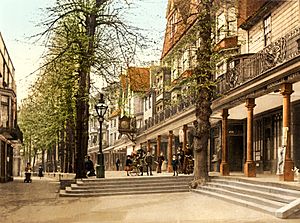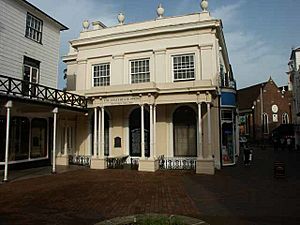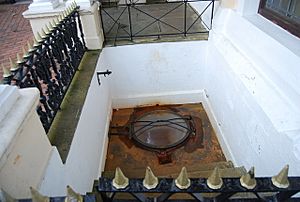The Pantiles facts for kids
The Pantiles is a famous area in Royal Tunbridge Wells, Kent, England. It has beautiful Georgian buildings and a covered walkway called a colonnade. This special place grew around a unique water source.
The area was created after a special spring was found in the early 1600s. Today, The Pantiles is a popular spot for visitors. You can find many interesting shops, art galleries, and places to eat. There is also a Farmers Market every other Saturday. In summer, jazz bands play music outdoors, which many people enjoy.
Contents
The Chalybeate Spring
The Chalybeate spring is at one end of The Pantiles. Its water is rich in iron, which gives it a special taste. A building called the Dipper's Hall overlooks the spring.
Every summer, visitors can try the spring water. People dressed in old-fashioned costumes, called 'Dippers', serve the water.
History of The Pantiles
How the Wells Were Discovered (1606-1659)
The story of The Pantiles began in 1606. A nobleman named Dudley Lord North discovered the waters. He was a well-known person in the court of King James I.
Lord North had been living a very busy life and was not feeling well. He went to the countryside to try and get better. On his way back to London, he found the spring. He drank the water and felt completely healthy again. He even lived to be 80 years old!
People became very interested in these waters. Lord Abergavenny helped clear the area around the spring. He built wells and surrounded them with stone and railings. More visitors came, and they also said the water helped them feel better.
At first, there were not many places to stay nearby. The closest lodging was about 5 miles away. But important people still visited. This included Henrietta Maria of France, who was the wife of King Charles I. She camped in fancy tents nearby after her son was born. Her son later became King Charles II.
The wells were first called Frant Wells. Later, they were named Queen Mary’s Wells, after Queen Mary II. Finally, they got their current name, Tunbridge Wells.
In 1638, two walkways were created. These were called the Upper and Lower Walks. Trees were planted, and wooden buildings were built along the sides.
After the English Civil War (1660-1738)
During the English civil wars, the wells were not looked after. After the war ended, many improvements were made. An assembly room and a bowling green were built.
In 1664, Queen Catherine of Braganza was told to drink the waters because she was ill. This made the wells even more popular.
In 1687, a fire destroyed the wooden buildings along the Walks. New buildings were later built with the covered walkways, or colonnades. These colonnades give The Pantiles its special look today. By 1697, coffee houses had also opened in the area.
The Rusthall Manor Act (1739 Onwards)
In 1739, an important law called the Rusthall Manor Act was signed. This law made sure that the Walks, the Wells, and the Dipper's Hall would always be open to everyone. It also stopped any more buildings from being built on Tunbridge Wells Common.
Why is it Called "The Pantiles"?
The name "Pantiles" comes from the special paving used there.
- In 1700, the Upper Walks were paved with "pantiles."
- A map from 1738 shows the area looking much like it does today.
- In 1793, most of these pantiles were removed and replaced with stone. The area was then called The Parade.
- In 1887, the old name "The Pantiles" was brought back.
The paving "pantiles" were not like the tiles used on roofs. These were one-inch thick square tiles. They were made from heavy clay and shaped in a wooden pan before being baked. This is how they got their name.
Most of the buildings in The Pantiles are listed. This means they are important historical buildings. Many were built in the early to mid-1800s. Some are even older, like No. 7, which dates back to around 1660.
Events and Festivals
The Pantiles hosts many fun events throughout the year. These include a food festival and a music festival. There is also a fashion market and an outdoor art show.
During the summer, The Pantiles has a special jazz season. Free outdoor jazz concerts are held on Thursday evenings. Musicians play on the historic bandstand, which is a great place to enjoy the music.




